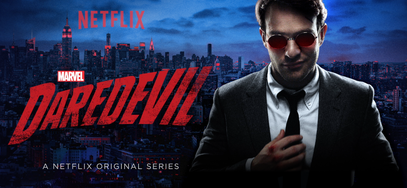 by Preston Tolliver As far as comic flicks go, there's no question who's always ruled the box office. Marvel, for the last several years, has churned out at least two major films a year, running laps both in fan interest and profits around the company that has only given us a handful of noteworthy films in the last 10 years. But where DC Comics has lacked in feature films, it's made up for it in television. With “Arrow” in its third season and “The Flash” and “Gotham” entering their highly-anticipated (and very, very good) first seasons, DC looked like it had finally gained the upper hand on Marvel. And then Marvel pulled the rug out from under them. “Daredevil” premiered April 10 on Netflix, the first of five series the streaming service had announced for Marvel (the others being Luke Cage, Iron Fist, Jessica Jones and a Defenders series following the four characters' own seasons, in which it'll bring all four back as a single team). DC's shows face certain limitations just in their respective networks — with “Arrow” and “The Flash” airing on the CW, and “Gotham” on Fox, there are a lot of restrictions that prevent the shows from doing some things that fans have grown to like. The language is kept generally family-friendly, and their action scenes are reduced to mere skirmishes. “Daredevil” didn't have those restrictions. With it airing on Netflix, the show was able to introduce a new darkness to the Marvel universe, and with that an extraordinary level of grit. While the show would be deemed too dark for primetime networks, it's something that could fit in easily on AMC, matching the channel's shows in both intense storytelling and creativity (If you need proof of the show's uniqueness, just watch this scene. You always expect some sort of breathtaking battle scene in any action movie. You don't expect it to be filmed in a single take. With “Daredevil,” Marvel introduced a brand new, unprecedented phase to its cinematic universe: it abandoned the lightheartedness that has brightened the central storylines in all its films — jokes made throughout the movies keep viewers from worrying too much about the film's outcome, while a hurried attempt to fit as much action as possible into two-and-a-half hours keep at bay any emotional connection to any of the central characters. Whereas movie-makers are awarded maybe 30 minutes to an hour to explore a character's depth before that character would be required to plunge into an hour of endless kicks, punches and shield-throws or web-slinging. Protagonists have it even worse. First off, just to get it out of the way, the 2003 “Daredevil” film was awful. In that film, Michael Clarke Duncan played The Kingpin, a man hell-bent on taking over Hell's Kitchen for his own profit. But as good as Clarke Duncan was (and he was probably the only good part of that movie), that's about all he gave us. And it wasn't because of any flaw of the movie — the flaw, in this case, was that it was a movie. In the Netflix series, however, we get significant parts of several episodes that explore the life of Wilson Fisk, and how he became the Kingpin. Unlike the movie, we see more than his life in a world against the Devil. We find out why he is the Kingpin. 2003's movie gave us the Kingpin; the series gave us Wilson Fisk. The series was so well-received that Marvel and Netflix have announced a second season, and let's hope it continues to plunge into darkness. If they bring in fan-favorite Bullseye, Matt Murdock's biggest rival, there's nowhere to go but into the dusk. This series, the first of the five, also shows that maybe Marvel's niche isn't in its films. Sure, the films are great, but they lack heart. Here's hoping Marvel doesn't stop its series after “The Defenders” (please, please give us a Punisher series). My brother asked me after “Daredevil” first arrived on Netflix if the show is darker than “Gotham”; the truth is, “Daredevil” makes “Gotham” look like a sunny day, while DC is back to looking like second fiddle.
0 Comments
Leave a Reply. |
Archives
July 2024
|